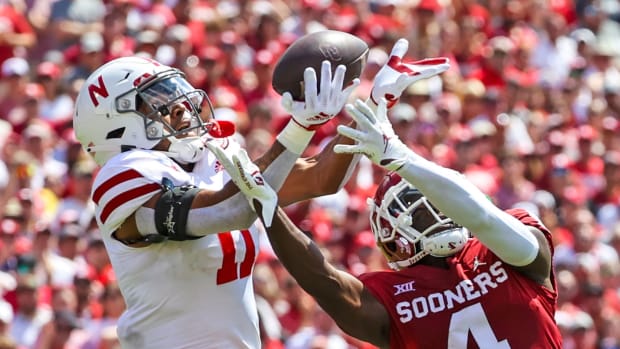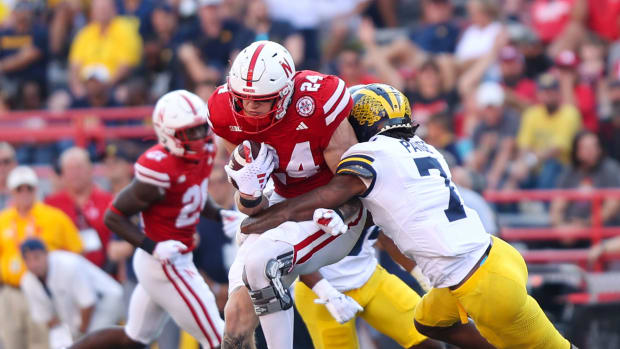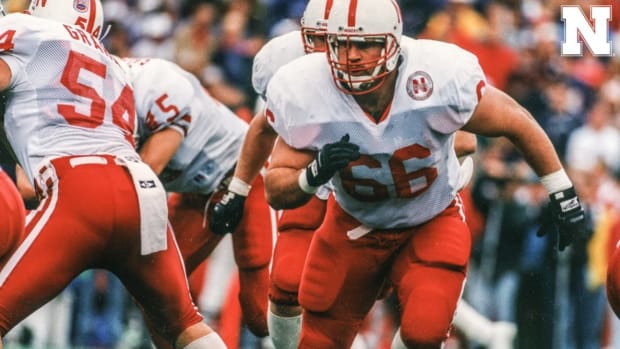Dave Feit: Cupcakes and the Path to the Playoff

Nebraska football head coach Matt Rhule recently sat down with the Omaha World-Herald’s Tom Shatel for an extended interview.
Among the topics they discussed is the scheduling of future nonconference games. Changes may be on the horizon as the Big Ten adds four new name-brand teams and the college football playoff expands to 12 teams. Shatel wrote about it in his weekly “First Downs and Second Guesses” column.
In the column, Shatel wrote that Rhule “indicated he would be against playing nonconference games against Power Five teams.” This line — and the assumptions people have drawn from it* — have generated a ton of reaction from media and fans.
*I’d like to point out that Rhule is not quoted as saying he wants Nebraska to stop playing Power Five teams in the nonconference. Maybe that is what he meant. Maybe not.
I’m not suggesting Shatel is intentionally twisting Rhule’s words or trying to create controversy: Tom is too much of a pro to do that. But I will note that in his first 15 months at Nebraska, Matt Rhule has been very careful and intentional with what he says on the record. I’ve learned to take what he says at face value.
In the column, Rhule is quoted as saying “In a year where you hope to play 15 or 16 games, why would you elect to play a really tough game early?” I read this as a valid scheduling concern from a coach who began his Nebraska tenure with back-to-back road games against Power Five schools … which resulted in back-to-back losses. That doesn’t necessarily mean he’s opposed to playing a team like Arizona or Oklahoma State in Week 3, just that he’d (likely) prefer to ramp up the competition level.
It’s quite possible that Rhule said something — either not quoted in the column or off the record — that made it clear he doesn’t want any more Power Five teams in the non-con. But the closest thing I can find is this: “I think personally with 18 teams (in the Big Ten) you should give yourself the best chance with your scheduling.”
I don’t consider that quote to be a cause for panic. Coaches might publicly say they’ll travel to Uzbekistan to play a game, while secretly wishing they didn’t have to play at #3 Oklahoma. When your job security is directly tied to your ability to win games, it is natural to not want a grueling gauntlet of a schedule.
But for the sake of argument, let’s assume Rhule would like to end Nebraska’s traditional nonconference scheduling model.
As we move into a new era of college football, is that a bad thing?
* * *
Before we get too far down the road, let’s get on the same page about Nebraska’s nonconference scheduling in the 21st century.
In 2016, the Big Ten adopted a nine-game conference scheduling model, which limited teams to three nonconference games. If we look at all of Nebraska’s nonconference football games starting in 2016 (and including the 2024 season*) a definite pattern emerges:
- One game (home or away) against a Power Five school: The nonconference P5 games have all been home-and-home matchups. It’s worth mentioning that the opponent for two of these games (Oregon) will play Nebraska in 2026 and 2027 as a member of the Big Ten Conference.
- One or two games (all at home) against FBS teams from non-power conferences: The canceled Akron game from 2018 is included here. Five times (including the 2018 season) Nebraska scheduled two FBS teams in a season.
- A home game every other year (on average) against FCS teams: Including the 2018 Bethune Cookman game (a late addition to replace the canceled Akron game) Nebraska has had four FCS teams on its schedule between 2016 and 2024.
*This excludes 2020, when the Big Ten played a conference-only season, but includes the 2018 opener versus Akron, which was canceled due to weather.
If we expand back to 2000, when Nebraska would regularly play four nonconference games in a season, the same trends occur with only a few exceptions: three seasons where NU played multiple Power Five teams in the non-con (2000, 2005 and 2007) and three road games against FBS opponents (Southern Miss in 2003, Wyoming in 2011 and Fresno State in 2014).
* * *
Now that we know what the nonconference scheduling has been, what might it look like in the future?
As Shatel wrote in his column, Nebraska’s future scheduled games against Arizona, Oklahoma, Oklahoma State and Tennessee "would probably go away." That is speculation, but there is good reason to believe he’s right.
Let’s start with Nebraska’s Big Ten schedule going forward. Not only did the league add four strong teams in Oregon, UCLA, USC and Washington, it also eliminated the East and West divisions. Even though Nebraska failed to take advantage of it, the Huskers spent the better part of a decade in one of the weakest divisions in the Power Five.
Starting this fall, Nebraska trades Northwestern for UCLA and Minnesota for USC, while keeping its almost annual matchup against Ohio State. In 2026 and 2027, the Huskers will face only two of the former B1G West teams (Iowa and Illinois).
The goal of college football is the make the playoffs. The consensus opinion is the CFP Committee rewards teams with the best records (whose quarterbacks have not suffered season-ending injuries) instead of rewarding teams that played — and lost — tough nonconference games.
So why should Nebraska limit (if not avoid) the number of Power Five teams on its future nonconference schedules? Well, that’s what (almost) everybody else is doing.
As a parent, I hate that answer. But in a multimillion-dollar industry where so much hangs in the balance, following the crowd makes sense. We cheer for the coach who bucks conventional wisdom and goes for it on 4th and 8 … until it blows up in his face.
Michigan made the playoffs in 2022 and 2023. It’s worth noting that Michigan has not played a Power Five team in the non-con since Washington traveled to Ann Arbor in 2021. While the Wolverines will host Texas in 2024, they haven’t played a nonconference road game since a 2019 trip to Notre Dame. Michigan is not the only one that has chosen this path, but the Wolverines’ success will lead to imitation.
Some conferences — notably, the SEC — do not play nine conference games, leaving an extra spot for a nonconference game. Often, these games are against FBS or FCS teams. Does the committee account for this, or is the prevailing opinion that playing a tough SEC schedule makes up that November game against Mercer?
Sure, Nebraska could continue to maintain its existing scheduling strategy, but I believe it would put them at a disadvantage to the Huskers’ P5 peers.
I’ve seen the argument that Nebraska should be a leader and set a scheduling example for the rest of the sport (a noble, if naïve, aspiration). Rhule is right to want a consistent scheduling model across all conferences, but there’s no reason for him or his AD to die on the hill first.
* * *
The truth is that competitive advantages and disadvantages matter in college sports. Finding those little margins is the reason teams now employ a small army of analysts, why collectives exist, and why you likely know who Conor Stallions is. Nebraska’s weight training regime used to be a competitive advantage until every other school decided to copy it. Now it is the norm.
As things stand today, there is no competitive advantage to be gained from scheduling Tennessee and Oklahoma State when Chattanooga and Tulsa will likely deliver a better ROI.
You can think of it as keeping up with the Joneses, or removing landmines before somebody steps on them.
Until the committee demonstrates that strength of schedule matters and/or views an out-of-conference P5 road loss the same as a home win over a FCS team, there is zero incentive for Nebraska to schedule big names in the nonconference.
* * *
I’m aware that defending a (likely) cupcake-heavy nonconference schedule may not be a popular opinion.
For fans of college football (and/or those who get paid to write or talk about the sport), it can be disappointing to lose the marquee cross-conference matchups that highlight the September TV schedules. Personally, I don’t give a crap if the second Saturday in September is packed with interesting games or not. I care if my team wins — regardless of who they play. But I may be in the minority.
Season ticket holders (such as myself) may question why we’re paying high prices (plus donations) to attend what — in a best-case scenario* — is a 40-point win over an FCS or mediocre FBS team.
*I’m continually surprised that P5 schools continue to schedule FCS teams. In the last decade, 86 FCS teams have pulled an upset over a higher-division foe, with 21 of those being Power Five teams. To me, FCS teams are all risk and little reward.
You may not have much interest in going to the Nebraska-Houston Christian game in 2025, but I suspect the rest of the home slate (conference games against Michigan, Michigan State, Iowa, USC and Northwestern) will justify the price of season tickets.
I have sympathy for those Husker fans who enjoy traveling to the unique nonconference road games Nebraska plays in. Going to Notre Dame in 2000 to watch Nebraska remains the standard by which all other Husker road trips are judged.
I know many fans who have had the Tennessee game (currently scheduled for 2027) circled since it was announced over a decade ago. It will be disappointing if that game — and future games against Oklahoma — are dropped.
* * *
So how do we get out of this trend of easier nonconference schedules?
I think the CFP Committee holds the most power. It can send a message when it selects teams for the first iteration of the 12-team playoff this fall.
Maybe the TV networks will demand more big-name matchups in the nonconference season to justify their big contracts.*
*In theory, ESPN, FOX and others could facilitate more entertaining nonconference games in September. But it’s more likely that the TV partners will just move a few conference matchups to the early weeks to spread out the content they’re paying for.
Maybe fans will revolt and not buy tickets when Middle Nowhere State comes to take its 40-point beating. Athletic directors tend to notice half-full stadiums.
But I’d wager that we’ll just have to wait for the next seismic shift to adjust the college football landscape.
For better or worse, that could happen any day now.






